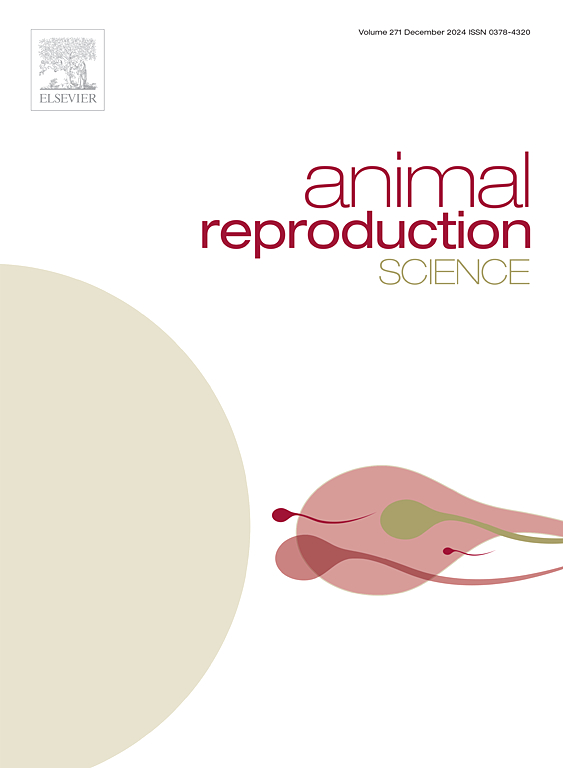Successive seminal collections from Piaractus mesopotamicus in biofloc technology during the reproductive period
IF 2.2
2区 农林科学
Q1 AGRICULTURE, DAIRY & ANIMAL SCIENCE
引用次数: 0
Abstract
This study aimed to evaluate the sperm characteristics of pacu (Piaractus mesopotamicus) maintained in biofloc technology (BFT) in comparison partial water renewal system (PWR). Twenty-five males in two production systems were used: 12 in BFT and 13 in PWR. The fish were induced to reproduce in two moments: before the distribution in the experimental units of both systems; and after maintenance of the breeders for 42 days in the systems. After 42 days, only 23 % of PWR fish released semen, compared to 75 % of those kept in BFT. This improvement in the reproduction of pacu broodstock kept in BFT can be corroborated by the higher (P < 0.05) gonadosomatic index of broodstock kept in BFT (0.387) compared to those kept in PWR (0.135), and also due to more advanced germ cell stages (spermatocytes, spermatids, spermatozoa) in broodstock testes maintained in BFT at 42 days. Despite a decrease in sperm concentration in BFT from the first to the second collection, the total number of spermatozoa did not differ significantly. Plasma membrane integrity associated with mitochondrial potential was worse for broodstock kept in PWR compared to those kept in BFT. The total amount of spermatozoa produced per liter of water used in BFT was 46,406, surpassing 304 of PWR's system. Maintaining pacu breeders in BFT for 42 days is more efficient for induced reproduction in situations of successive semen collections compared to the PWR system, with improved water optimization.
生物絮团技术在繁殖期内连续收集美索不达米亚鼠的精液
本研究旨在评估用生物絮团技术(BFT)饲养的鲮鱼(Piaractus mesopotamicus)的精子特征,并与部分水更新系统(PWR)进行比较。在两种生产系统中使用了 25 只雄性貔貅:其中 12 条在 BFT 系统中,13 条在 PWR 系统中。诱导鱼类繁殖分为两个阶段:在两个系统的实验单元中进行分配之前;以及在系统中饲养 42 天之后。42 天后,PWR 系统中只有 23% 的鱼释放出精液,而 BFT 系统中则有 75% 的鱼释放出精液。在 BFT 系统中饲养的鲮鱼的生殖能力有所提高,其性腺指数(0.387)高于在 PWR 系统中饲养的鲮鱼(0.135)(P < 0.05),而且在 BFT 系统中饲养 42 天的鲮鱼睾丸的生殖细胞阶段(精母细胞、精子细胞、精子细胞)更高。尽管 BFT 中的精子浓度从第一次采集到第二次采集有所下降,但精子总数并无显著差异。与线粒体电位相关的质膜完整性,在压水堆中饲养的鱼种比在BFT中饲养的鱼种更差。在 BFT 系统中,每升水产生的精子总数为 46 406 个,超过了 PWR 系统的 304 个。在连续采集精液的情况下,与压水反应堆系统相比,在 BFT 系统中饲养 42 天的稚鲤种群的诱导繁殖效率更高,水质优化效果也更好。
本文章由计算机程序翻译,如有差异,请以英文原文为准。
求助全文
约1分钟内获得全文
求助全文
来源期刊

Animal Reproduction Science
农林科学-奶制品与动物科学
CiteScore
4.50
自引率
9.10%
发文量
136
审稿时长
54 days
期刊介绍:
Animal Reproduction Science publishes results from studies relating to reproduction and fertility in animals. This includes both fundamental research and applied studies, including management practices that increase our understanding of the biology and manipulation of reproduction. Manuscripts should go into depth in the mechanisms involved in the research reported, rather than a give a mere description of findings. The focus is on animals that are useful to humans including food- and fibre-producing; companion/recreational; captive; and endangered species including zoo animals, but excluding laboratory animals unless the results of the study provide new information that impacts the basic understanding of the biology or manipulation of reproduction.
The journal''s scope includes the study of reproductive physiology and endocrinology, reproductive cycles, natural and artificial control of reproduction, preservation and use of gametes and embryos, pregnancy and parturition, infertility and sterility, diagnostic and therapeutic techniques.
The Editorial Board of Animal Reproduction Science has decided not to publish papers in which there is an exclusive examination of the in vitro development of oocytes and embryos; however, there will be consideration of papers that include in vitro studies where the source of the oocytes and/or development of the embryos beyond the blastocyst stage is part of the experimental design.
 求助内容:
求助内容: 应助结果提醒方式:
应助结果提醒方式:


